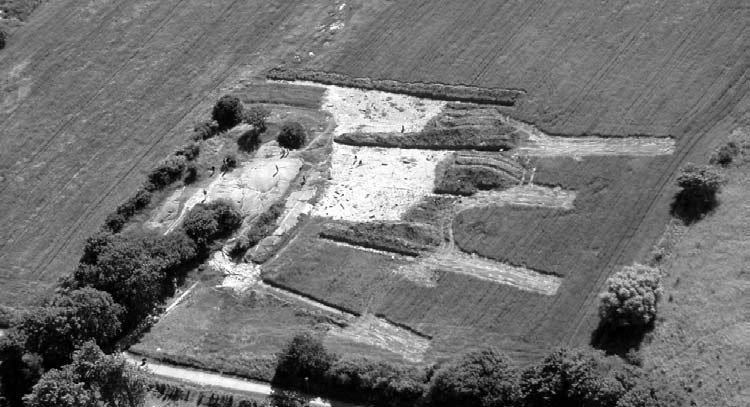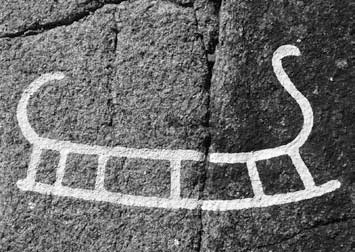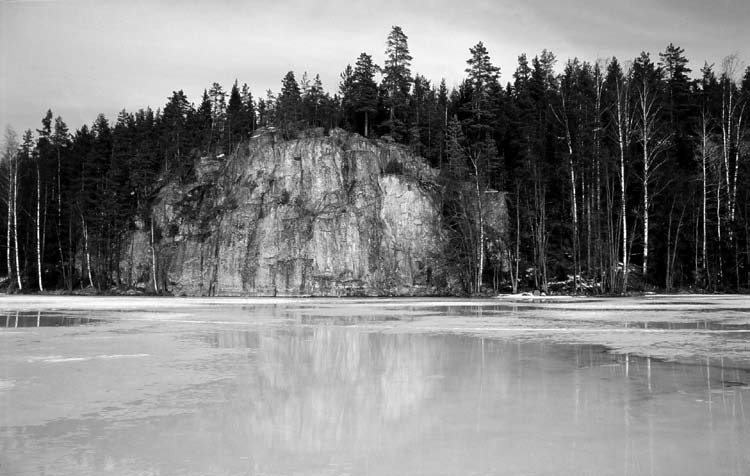Articles: Adoranten 2006
Arkæologiske udgravninger ved de bornholmske helleristningsklipper Madsebakke og Ll. Strandbygård. By Palle Ø. Sørensen
 I perioden 2003 til 2005 gennemførte Nationalmuseet og Bornholms Museum, en række arkæologiske udgravninger ved de Bornholmske helleristningsklipper. Undersøgelserne startede med en række mindre prøvegravninger for at klarlægge det forskningsmæssige potentiale i sådanne udgravninger, som ikke tidligere har været gennemført på Bornholm, og i virkeligheden også kun er blevet foretaget i meget sparsom omfang i det øvrige nordiske område. Prøvegravningen i 2003 blev finansieret af midler fra det fælles nordiske RANE projekt og undersøgelserne viste, at der fandtes en række forskellige anlægstyper tæt op til de enkelte klipper med helleristninger. På denne baggrund blev der søgt om en stor bevilling fra det humanistiske forskningsråd og da denne ansøgning blev imødekommet, kunne der i perioden 2004-2005, foretages egentlige arkæologiske udgravninger ved en række af de bornholmske helleristningsklipper. Størstedelen af bevillingen blev dog brugt til en større udgravning ved Danmarks største helleristningsfelt på Madsebakke på nordbornholm, da bevaringsforholdene her viste sig at være usædvanligt gode.
I perioden 2003 til 2005 gennemførte Nationalmuseet og Bornholms Museum, en række arkæologiske udgravninger ved de Bornholmske helleristningsklipper. Undersøgelserne startede med en række mindre prøvegravninger for at klarlægge det forskningsmæssige potentiale i sådanne udgravninger, som ikke tidligere har været gennemført på Bornholm, og i virkeligheden også kun er blevet foretaget i meget sparsom omfang i det øvrige nordiske område. Prøvegravningen i 2003 blev finansieret af midler fra det fælles nordiske RANE projekt og undersøgelserne viste, at der fandtes en række forskellige anlægstyper tæt op til de enkelte klipper med helleristninger. På denne baggrund blev der søgt om en stor bevilling fra det humanistiske forskningsråd og da denne ansøgning blev imødekommet, kunne der i perioden 2004-2005, foretages egentlige arkæologiske udgravninger ved en række af de bornholmske helleristningsklipper. Størstedelen af bevillingen blev dog brugt til en større udgravning ved Danmarks største helleristningsfelt på Madsebakke på nordbornholm, da bevaringsforholdene her viste sig at være usædvanligt gode.
Read the article as pdf
 I perioden 2003 til 2005 gennemførte Nationalmuseet og Bornholms Museum, en række arkæologiske udgravninger ved de Bornholmske helleristningsklipper. Undersøgelserne startede med en række mindre prøvegravninger for at klarlægge det forskningsmæssige potentiale i sådanne udgravninger, som ikke tidligere har været gennemført på Bornholm, og i virkeligheden også kun er blevet foretaget i meget sparsom omfang i det øvrige nordiske område. Prøvegravningen i 2003 blev finansieret af midler fra det fælles nordiske RANE projekt og undersøgelserne viste, at der fandtes en række forskellige anlægstyper tæt op til de enkelte klipper med helleristninger. På denne baggrund blev der søgt om en stor bevilling fra det humanistiske forskningsråd og da denne ansøgning blev imødekommet, kunne der i perioden 2004-2005, foretages egentlige arkæologiske udgravninger ved en række af de bornholmske helleristningsklipper. Størstedelen af bevillingen blev dog brugt til en større udgravning ved Danmarks største helleristningsfelt på Madsebakke på nordbornholm, da bevaringsforholdene her viste sig at være usædvanligt gode.
I perioden 2003 til 2005 gennemførte Nationalmuseet og Bornholms Museum, en række arkæologiske udgravninger ved de Bornholmske helleristningsklipper. Undersøgelserne startede med en række mindre prøvegravninger for at klarlægge det forskningsmæssige potentiale i sådanne udgravninger, som ikke tidligere har været gennemført på Bornholm, og i virkeligheden også kun er blevet foretaget i meget sparsom omfang i det øvrige nordiske område. Prøvegravningen i 2003 blev finansieret af midler fra det fælles nordiske RANE projekt og undersøgelserne viste, at der fandtes en række forskellige anlægstyper tæt op til de enkelte klipper med helleristninger. På denne baggrund blev der søgt om en stor bevilling fra det humanistiske forskningsråd og da denne ansøgning blev imødekommet, kunne der i perioden 2004-2005, foretages egentlige arkæologiske udgravninger ved en række af de bornholmske helleristningsklipper. Størstedelen af bevillingen blev dog brugt til en større udgravning ved Danmarks største helleristningsfelt på Madsebakke på nordbornholm, da bevaringsforholdene her viste sig at være usædvanligt gode.
Read the article as pdf
Excavations at the Rock Carvings at Torp in Skredsvik in Bohuslän, Sweden in the early 1990s. By Ulf Bertilsson & Catarina Bertilsson
 In recent years there has been a series of excavations in front of rock carving panels in Northern Bohuslän. These excavations have revealed a lot of hitherto unknown archaeological finds and new information. In that way new light has been shed on the context of the rock art and the engraved granite panels. Already before those, in the early years of the 1990s the authors performed archaeological excavations at two of the most spectacular rock art sites in Bohuslän, namely at Torp in Skredsviks parish and at Fossum in Tanum parish. Due to a number of unforeseen circumstances that will not be accounted for here, the reports from these excavations have been delayed for many years. Thanks to the excellent initiative of the editors, Gerhard Milstreu and Henning Prøhl, to let the present issue of Adoranten focus on excavations in connection with rock carvings the present authors have now been offered an opportunity to finally tighten this lacuna. However, due to the rather extensive information from these excavations this paper will focus on the excavation at Torp in Skredsvik whilst a report from Fossum in Tanum will have to wait for yet some time.
In recent years there has been a series of excavations in front of rock carving panels in Northern Bohuslän. These excavations have revealed a lot of hitherto unknown archaeological finds and new information. In that way new light has been shed on the context of the rock art and the engraved granite panels. Already before those, in the early years of the 1990s the authors performed archaeological excavations at two of the most spectacular rock art sites in Bohuslän, namely at Torp in Skredsviks parish and at Fossum in Tanum parish. Due to a number of unforeseen circumstances that will not be accounted for here, the reports from these excavations have been delayed for many years. Thanks to the excellent initiative of the editors, Gerhard Milstreu and Henning Prøhl, to let the present issue of Adoranten focus on excavations in connection with rock carvings the present authors have now been offered an opportunity to finally tighten this lacuna. However, due to the rather extensive information from these excavations this paper will focus on the excavation at Torp in Skredsvik whilst a report from Fossum in Tanum will have to wait for yet some time.
Read the article as pdf
 In recent years there has been a series of excavations in front of rock carving panels in Northern Bohuslän. These excavations have revealed a lot of hitherto unknown archaeological finds and new information. In that way new light has been shed on the context of the rock art and the engraved granite panels. Already before those, in the early years of the 1990s the authors performed archaeological excavations at two of the most spectacular rock art sites in Bohuslän, namely at Torp in Skredsviks parish and at Fossum in Tanum parish. Due to a number of unforeseen circumstances that will not be accounted for here, the reports from these excavations have been delayed for many years. Thanks to the excellent initiative of the editors, Gerhard Milstreu and Henning Prøhl, to let the present issue of Adoranten focus on excavations in connection with rock carvings the present authors have now been offered an opportunity to finally tighten this lacuna. However, due to the rather extensive information from these excavations this paper will focus on the excavation at Torp in Skredsvik whilst a report from Fossum in Tanum will have to wait for yet some time.
In recent years there has been a series of excavations in front of rock carving panels in Northern Bohuslän. These excavations have revealed a lot of hitherto unknown archaeological finds and new information. In that way new light has been shed on the context of the rock art and the engraved granite panels. Already before those, in the early years of the 1990s the authors performed archaeological excavations at two of the most spectacular rock art sites in Bohuslän, namely at Torp in Skredsviks parish and at Fossum in Tanum parish. Due to a number of unforeseen circumstances that will not be accounted for here, the reports from these excavations have been delayed for many years. Thanks to the excellent initiative of the editors, Gerhard Milstreu and Henning Prøhl, to let the present issue of Adoranten focus on excavations in connection with rock carvings the present authors have now been offered an opportunity to finally tighten this lacuna. However, due to the rather extensive information from these excavations this paper will focus on the excavation at Torp in Skredsvik whilst a report from Fossum in Tanum will have to wait for yet some time.
Read the article as pdf
Exploring the contemporary context of rock art. By Trond Lødøen
 This paper presents some results from archaeological excavations and surveys in the immediate surroundings of rock art sites in Western Norway. The results have been provided for a better background and a more nuanced debate concerning both the chronology of the rock art, the production of the rock art, and the fuller understanding of its meaning. Many years with focus only on images has in practice neglected archaeological material present in the immediate vicinity of the sites, representing the contemporary context of the images, thus weakening the rock art’s potential regarding knowledge about the past.
This paper presents some results from archaeological excavations and surveys in the immediate surroundings of rock art sites in Western Norway. The results have been provided for a better background and a more nuanced debate concerning both the chronology of the rock art, the production of the rock art, and the fuller understanding of its meaning. Many years with focus only on images has in practice neglected archaeological material present in the immediate vicinity of the sites, representing the contemporary context of the images, thus weakening the rock art’s potential regarding knowledge about the past.
Traditionally, within Scandinavian archaeology, and in particular before the 1960s, there was a clear distance between researchers who worked with rock art, and those more concerned with other archaeological remains, such as settlements, graves, etc. After the 1960s, this started to improve with a stronger focus on the relations between rock art on the one hand and graves, votive offerings and settlements on the other. However, an integration of archaeological material often present in the proximity of rock art sites, underneath turf or similar contexts have been less focused.
Read the article as pdf
 This paper presents some results from archaeological excavations and surveys in the immediate surroundings of rock art sites in Western Norway. The results have been provided for a better background and a more nuanced debate concerning both the chronology of the rock art, the production of the rock art, and the fuller understanding of its meaning. Many years with focus only on images has in practice neglected archaeological material present in the immediate vicinity of the sites, representing the contemporary context of the images, thus weakening the rock art’s potential regarding knowledge about the past.
This paper presents some results from archaeological excavations and surveys in the immediate surroundings of rock art sites in Western Norway. The results have been provided for a better background and a more nuanced debate concerning both the chronology of the rock art, the production of the rock art, and the fuller understanding of its meaning. Many years with focus only on images has in practice neglected archaeological material present in the immediate vicinity of the sites, representing the contemporary context of the images, thus weakening the rock art’s potential regarding knowledge about the past.Traditionally, within Scandinavian archaeology, and in particular before the 1960s, there was a clear distance between researchers who worked with rock art, and those more concerned with other archaeological remains, such as settlements, graves, etc. After the 1960s, this started to improve with a stronger focus on the relations between rock art on the one hand and graves, votive offerings and settlements on the other. However, an integration of archaeological material often present in the proximity of rock art sites, underneath turf or similar contexts have been less focused.
Read the article as pdf
Flere udgravninger ved helleristninger på Bornholm. En kort oversigt. By Flemming Kaul
 Det er ikke kun ved Madsebakke og ved Lille Strandbygård, at der i de seneste år er foretaget arkæologiske undersøgelser på Bornholm. Allerede gennem midler i det fællesnordiske EU-projekt RANE blev der ved andre helleristningslokaliteter udført mindre prøvegravninger. Gennem en bevilling fra Statens Humanistiske Forskningsråd blev det muligt at foretage videre arkæologiske undersøgelser – i et samarbejde mellem Bornholms Museum og Nationalmuseet (F.O. Nielsen 2006, 48-49). Ved de seneste undersøgelser har også Dronning Margrethe II’s Arkæologiske Fond bidraget.
Det er ikke kun ved Madsebakke og ved Lille Strandbygård, at der i de seneste år er foretaget arkæologiske undersøgelser på Bornholm. Allerede gennem midler i det fællesnordiske EU-projekt RANE blev der ved andre helleristningslokaliteter udført mindre prøvegravninger. Gennem en bevilling fra Statens Humanistiske Forskningsråd blev det muligt at foretage videre arkæologiske undersøgelser – i et samarbejde mellem Bornholms Museum og Nationalmuseet (F.O. Nielsen 2006, 48-49). Ved de seneste undersøgelser har også Dronning Margrethe II’s Arkæologiske Fond bidraget.
Read the article as pdf
 Det er ikke kun ved Madsebakke og ved Lille Strandbygård, at der i de seneste år er foretaget arkæologiske undersøgelser på Bornholm. Allerede gennem midler i det fællesnordiske EU-projekt RANE blev der ved andre helleristningslokaliteter udført mindre prøvegravninger. Gennem en bevilling fra Statens Humanistiske Forskningsråd blev det muligt at foretage videre arkæologiske undersøgelser – i et samarbejde mellem Bornholms Museum og Nationalmuseet (F.O. Nielsen 2006, 48-49). Ved de seneste undersøgelser har også Dronning Margrethe II’s Arkæologiske Fond bidraget.
Det er ikke kun ved Madsebakke og ved Lille Strandbygård, at der i de seneste år er foretaget arkæologiske undersøgelser på Bornholm. Allerede gennem midler i det fællesnordiske EU-projekt RANE blev der ved andre helleristningslokaliteter udført mindre prøvegravninger. Gennem en bevilling fra Statens Humanistiske Forskningsråd blev det muligt at foretage videre arkæologiske undersøgelser – i et samarbejde mellem Bornholms Museum og Nationalmuseet (F.O. Nielsen 2006, 48-49). Ved de seneste undersøgelser har også Dronning Margrethe II’s Arkæologiske Fond bidraget.
Read the article as pdf
Rock Painting Sites in Finland. Archaeological Excavations and Underwater Investigations. By Helena Taskinen
 At the time of this writing (2006), over 120 rock-painting sites are known of in Finland. These paintings were originally made on barren rock faces situated perpendicular to a body of water in front of them. Despite changes caused by land uplift, most of these paintings are still directly adjacent to water. For obvious reasons, normal archaeological excavations cannot be carried out in the areas next to the paintings, but there have been underwater investigations in locations in front of a number of painted rock faces.
At the time of this writing (2006), over 120 rock-painting sites are known of in Finland. These paintings were originally made on barren rock faces situated perpendicular to a body of water in front of them. Despite changes caused by land uplift, most of these paintings are still directly adjacent to water. For obvious reasons, normal archaeological excavations cannot be carried out in the areas next to the paintings, but there have been underwater investigations in locations in front of a number of painted rock faces.
Read the article as pdf
 At the time of this writing (2006), over 120 rock-painting sites are known of in Finland. These paintings were originally made on barren rock faces situated perpendicular to a body of water in front of them. Despite changes caused by land uplift, most of these paintings are still directly adjacent to water. For obvious reasons, normal archaeological excavations cannot be carried out in the areas next to the paintings, but there have been underwater investigations in locations in front of a number of painted rock faces.
At the time of this writing (2006), over 120 rock-painting sites are known of in Finland. These paintings were originally made on barren rock faces situated perpendicular to a body of water in front of them. Despite changes caused by land uplift, most of these paintings are still directly adjacent to water. For obvious reasons, normal archaeological excavations cannot be carried out in the areas next to the paintings, but there have been underwater investigations in locations in front of a number of painted rock faces.
Read the article as pdf

|

